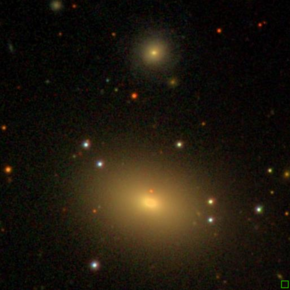| NGC 499 | |
|---|---|
 | |
| Observation data (J2000[1] epoch) | |
| Constellation | Pisces[2] |
| Right ascension | 01h 23m 11.5s[3] |
| Declination | +33° 27′ 28″[3] |
| Redshift | +0.014691 ± 0.000117[1] |
| Heliocentric radial velocity | (4372 ± 35.2) km/s[1] |
| Distance | 197 Mly[4] |
| Apparent magnitude (V) | 12.2[2] |
| Characteristics | |
| Type | E-S0[2] |
| Apparent size (V) | 1.7' × 1.3'[2] |
| Other designations | |
| PGC 5060, IC 1686, UGC 926, GC 289, MCG 5-4-38, 2MASS J01231145+3327362, H 3.158, h 106, CGCG 502-059[2][1][5] | |
NGC 499, also occasionally referred to as PGC 5060, IC 1686 or GC 289, is a lenticular galaxy in the constellation Pisces.[2] It is located approximately 197 million light-years from the Solar System[4] and was discovered on 12 September, 1784 by astronomer William Herschel.[5]
The NGC 499 Group is named after the galaxy.[3]
Observation history
[edit]The object was discovered by Herschel along with NGC 495 and NGC 496. He initially described the discovery as "Three [NGC 499 along with NGC 495 and 496], eS and F, forming a triangle.". As he observed the trio again the next night, he was able to make out more detail: "Three, forming a [right triangle]; the [right angle] to the south NGC 499, the short leg preceding [NGC 496], the long towards the north [NGC 495]. Those in the legs [NGC 496 and 495] the faintest imaginable; that at the rectangle [NGC 499] a deal larger and brighter, but still very faint."[6]
NGC 499 was later also observed by William Herschel's son John Herschel[5] and independently found by Stéphane Javelle in 1899.[6]
See also
[edit]References
[edit]- ^ a b c d "NGC 499". SIMBAD. Centre de données astronomiques de Strasbourg. Retrieved 2017-11-07.
- ^ a b c d e f "Revised NGC Data for NGC 499". spider.seds.org. Retrieved 2017-10-05.
- ^ a b c "Your NED Search Results". ned.ipac.caltech.edu. Retrieved 2017-11-07.
- ^ a b An object's distance from Earth can be determined using Hubble's law: v=Ho is Hubble's constant (70±5 (km/s)/Mpc). The relative uncertainty Δd/d divided by the distance is equal to the sum of the relative uncertainties of the velocity and v=Ho
- ^ a b c "New General Catalog Objects: NGC 450 - 499". cseligman.com. Retrieved 2017-11-07.
- ^ a b "astronomy-mall.com/Adventures.In.Deep.Space/NGC%201-7840%20complete.htm". Astronomy Mall. Retrieved 2017-11-07.
External links
[edit]- NGC 499 on WikiSky: DSS2, SDSS, GALEX, IRAS, Hydrogen α, X-Ray, Astrophoto, Sky Map, Articles and images
- SEDS
Well, that’s interesting to know that Psilotum nudum are known as whisk ferns. Psilotum nudum is the commoner species of the two. While the P. flaccidum is a rare species and is found in the tropical islands. Both the species are usually epiphytic in habit and grow upon tree ferns. These species may also be terrestrial and grow in humus or in the crevices of the rocks.
View the detailed Guide of Psilotum nudum: Detailed Study Of Psilotum Nudum (Whisk Fern), Classification, Anatomy, Reproduction